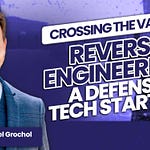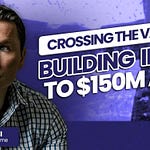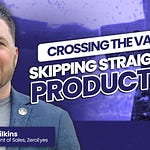Overview
Founded in 2019, Firehawk Aerospace is revolutionizing the propulsion market.
Firehawk designs, tests, and flies rockets for the U.S. government, and they 3D print the propellant, which makes it faster, cheaper, and less space intensive than traditional solid rocket fuel facilities.
Where most companies shoot for a 10X product, Firehawk has a 200X, with a rocket engine that takes 7 hours rather than 60 days to produce. The result is a product that is ready faster, and cheaper.
The Beginning
How did Will Edwards, a finance major from the University of Arkansas go from building HR software in Los Angeles to become the CEO of a leading propulsion company?
Will’s father was close friends with Ron Jones, a technologist obsessed with space, rockets, and additive manufacturing. Ron’s innovation was a hybrid rocket motor; that is, one powered by fuel that is half solid and half liquid. Many scientists worked on the problem of how to make such a propellant for years, but structural issues frustrated the design. The industry standard involves creating a mixture, casting it in a mold, letting it cure for several days (if not weeks), quality control, and refrigeration. The incumbents became used to this, and had little incentive to change the status quo. Enter Firehawk.
Ron’s fixation with additive manufacturing provided the cure: he was able to design fuel grains down to the sub-millimeter level, unlocking a new generation of hybrid engine.
The mission impact is significant: hybrid engines can restart mid-flight, whereas solid rocket motors are inert. This reduces the likelihood of accidents (which really excites the Department of Transportation as well!).
Business Model
When Ron and Will met, the question was what sort of business to build. Whereas there was lots of attention to launch, Will had an insight: there were only two incumbent rocket engines manufacturers selling to the Defense Department (Aerojet Rocketdyne and Orbital ATK). Hybrid rocket engines therefore represented a major disruption. Rather than going head to head with Elon Musk (SpaceX) and Peter Beck (Rocket Lab), Will and Ron decided to focus on rocket engines instead.
As they developed that technology, they found that 3D printing worked for solid rocket motors as well, and so expanded into that business.
Going to Market… Via Congress
The second major insight was that Will’s father had political experience and pushed the team to focus on Washington, DC from the start. There are only so many customers for solid rocket motors, and the U.S. government was chief among them.
The beginning was anything but smooth. On Will’s first trip to the Pentagon, an action officer greeted him by saying, “you’re making me miss my lunch break.”
With headquarters in Dallas, facilities in Midland, and locations around the country, Firehawk was well positioned for a different strategy. So they took to Capitol Hill, walking the halls of Congress to explain to members how they wanted to create dozens, hundreds, and eventually thousands of jobs in their respective districts.
They met with members of the House and Senate Appropriations Committees, Defense Appropriations Subcommittees, and the House and Senate Armed Services Committees.
Will shared the vision for the future of rocket motors, and the vision for the communities they would invest in and transform.
Once the members could tell they were sincere, they invited Will and team to apply for funding. The process required the Firehawk team to explain how the funding would be used, how it aligned with the president’s budget, and then a lot of waiting.
While Firehawk’s ask wasn’t funded in the first year, it was successful the second time around.
Which begs the question: then what?
Congressional funding doesn’t come to a company in the form of a check. It gets programmed as a line item in a budget. In Will’s case, their funding went to the Air Force Research Laboratory (AFRL).
That’s when Will and team learned another hard lesson: they hadn’t done the work to cultivate the Defense Department customer!
As a result, the AFRL program manager didn’t know what to do with the money, and other companies immediately made a play to take it.
By the time Will found where it had gone, it was slated to be spent elsewhere. This is where the procurement process kicked in. The Air Force didn’t listen to Will, and didn’t listen to the other company. Instead, they asked each company to show how they could do what was being requested in the appropriation. Firehawk created a white paper that triggered a Request for Proposal, and ultimately the team was awarded the full $5 million.
So while the 2022 appropriation didn’t reach the Firehawk bank until 2024, this is why today, Will says, “A lobbyist is the best investment a defense startup can make.”
Will and Firehawk made many of the mistakes in the book. But their tenacity, grit, and frankly - humility - in the face of adversity are what stand out about this team.
As a result, Firehawk is in an incredible (and unique) position to disrupt the market for rocket motors going forward.
Lessons
The Process - not the product - is the Innovation. Firehawk’s output (rocket motor) is the same device, with the same effect, as previous motors. But the process is orders of magnitude faster - and therefore better. It’s an interesting take on innovation; changing the path to get to the same outcome.
Partnership is a crucial part of growth. Will explains that he “wanted to create a radical partnership with the primes” ever since an early conversation at the Pentagon thought she had no use for propulsion companies because the technology was handled by the “big fish.” Firehawk’s disruption doesn’t come from rendering the market irrelevant or replacing the primes - it comes from getting them what they need orders of magnitude faster. And he puts them on his cap table, to ensure they are bought in! Which brings us to lesson number 3…
Know your true value - and focus on that. Will made a pretty counterintuitive point in explaining that if a prime wants to steal his IP, they are going to be able to do it - they’re large, have a ton of resources, and they have a positional advantage in the system. But they won’t, because of the real risk they’re solving for: development risk. Once Firehawk has de-risked the development cost of a product, any prime will be more than happy to buy this tested product and bring it to the end-user. That’s a big insight and one that other startups would really benefit from.
Multiple pathways are the way. Will explained that he’s pursuing a strategy of diversification inside DoD - SBIR Phase IIIs, IDIQs, and various contractual mechanisms. “We’re going to get to a program of record,” he states, matter-of-factly. “Building rockets, getting them qualified, getting them into a budget, and getting them into a budget is not a year or two project. We need options to make sure we have the best chance possible”













Ep. 07: How Firehawk Aerospace Won Congressional Appropriations to Fuel their Liftoff